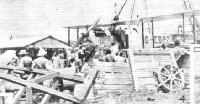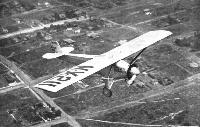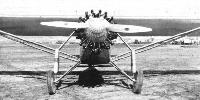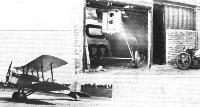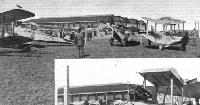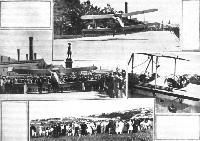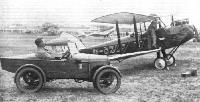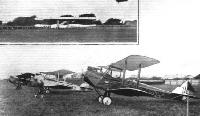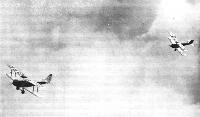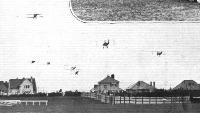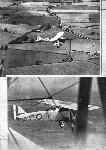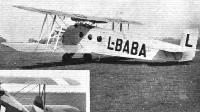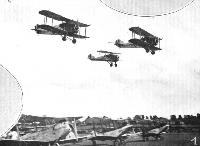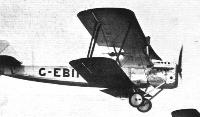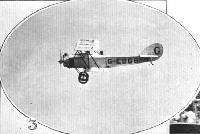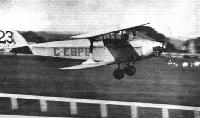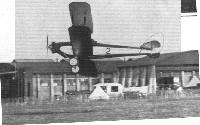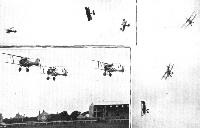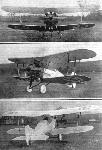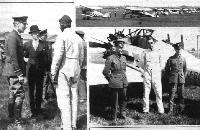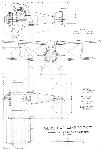Фотографии
-
AIR SURVEY IN THE EAST: The upper photograph shows a D.H.9 seaplane, belonging to the Air Survey Co., Ltd., in a somewhat temporary hangar at Port Swettenham. The group below includes Mr. R. C. Kemp, Mr. E. W. Bishop, Mr. R. Thorne, Mr. N. Vintcent and Mr. S. H. Trower.
Самолёты на фотографии: De Havilland D.H.9 - Великобритания - 1917
-
AIR SURVEYING UNDER DIFFICULTIES: These two photographs show the "aerodrome" of the Air Survey Co., Ltd., at Chittagong during a storm and, above, after the storm. The survey party has now left for the Malay States to carry out further surveys. During the Chittagong survey 1,200 square miles were covered by vertical photography. The Malay States survey will include a large-scale town plan of Georgetown, Penang. Mr Nevill Vintcent, one of the firm's pilots, has recently carried Burma's first air mail from Rangoon to Tavoy, a distance of 245 miles, in 3 1/2 hours, whereas the weekly mail boat takes 48 hours Mr R. C.Kemp, the managing director of the company, is now in the East superintending the work.
Самолёты на фотографии: De Havilland D.H.9 - Великобритания - 1917
-
FLYING IN AFRICA: One of snapshots brought back to England by Mrs. Eliott-Lynn. 1, Loading mails into the Kisumu-Khartoum machine (Fairey IIID).
Самолёты на фотографии: Fairey Fairey III - Великобритания - 1917
-
Регистрационный номер: G-EBPZ FLYING IN AFRICA: One of snapshots brought back to England by Mrs. Eliott-Lynn. 4, The Fairey IIID being hoisted on to the dock at Kisumu.
Самолёты на фотографии: Fairey Fairey III - Великобритания - 1917
-
PINEDO'S BIG FLIGHT: The Savoia S.55 mono-seaplane, fitted with two 500 h.p. Isotta-Fraschini engines.
Самолёты на фотографии: Savoia-Marchetti / SIAI S.55 - Италия - 1924
-
Регистрационный номер: NX211 [9] THE RYAN MONOPLANE: Three-quarter front view. Note the strutting of the undercarriage.
Самолёты на фотографии: Ryan NYP Spirit of St. Louis - США - 1927
-
Регистрационный номер: NX211 [9] THE RYAN MONOPLANE, TYPE N.Y.P.: Front view.
Самолёты на фотографии: Ryan NYP Spirit of St. Louis - США - 1927
-
Регистрационный номер: NX211 [9] "THE SPIRIT OF ST. LOUIS": View from the air of Capt. Lindbergh's transatlantic machine during a test flight. The machine was designed by Mr. Donald A. Hall, chief engineer and designer of Ryan Airlines of San Diego, California.
Самолёты на фотографии: Ryan NYP Spirit of St. Louis - США - 1927
-
Регистрационный номер: NX211 [9] "THE SPIRIT OF ST. LOUIS" SHOWS ITSELF: Before attempting to land on the few feet of Croydon Aerodrome available, Lindbergh made several circuits, and this was about as much of him that the majority of the people saw! These two views give a good idea of the general lines of the Ryan monoplane (220 h.p. Wright "Whirlwind") that has made history.
Самолёты на фотографии: Ryan NYP Spirit of St. Louis - США - 1927
-
Регистрационный номер: NX211 [9] LINDBERGH LANDS: Two views of "The Spirit of St. Louis" alighting in the narrow path left for it by the crowd, which can be seen, in the top picture, surging forward.
Самолёты на фотографии: Ryan NYP Spirit of St. Louis - США - 1927
-
Регистрационный номер: NX211 [9] HERO WORSHIP: Some of the 100,000 or more visitors to Croydon last Sunday who gave Lindbergh such a wonderful reception. The "unloosed" crowd is seen making for "The Spirit of St. Louis" - the wings of which are just visible above their heads.
Самолёты на фотографии: Ryan NYP Spirit of St. Louis - США - 1927
-
Регистрационный номер: NX211 [9] THE RYAN MONOPLANE. Side view.
Самолёты на фотографии: Ryan NYP Spirit of St. Louis - США - 1927
-
Регистрационный номер: NX211 [9] THE "WRIGHT SPIRIT": View of the business end of the Ryan monoplane "Spirit of St. Louis," on which Capt. Lindbergh flew from New York to Paris. Note the neat cowling around the Wright "Whirlwind" engine, spinner over the boss of the Duralumin propeller, and particularly the unusual undercarriage arrangement.
Самолёты на фотографии: Ryan NYP Spirit of St. Louis - США - 1927
-
Регистрационный номер: NX211 [9] THE RYAN MONOPLANE: This view of the machine in flight shows most of the special features. Particularly so as regards the undercarriage, the complete strutting of which is visible. Note also the side window.
Самолёты на фотографии: Ryan NYP Spirit of St. Louis - США - 1927
-
Регистрационный номер: G-EBQK Mr. Kenneth Hunter's S.E.5a, which he renovated himself. The photograph reveals the small garage space in which the old single-seater fighter can be kept with the wings taken down. It won the first race of its career at the Hampshire Pageant, when Mr. Youell carried off the Morris Cup and ?100.
Самолёты на фотографии: RAF S.E.5 - Великобритания - 1916
-
AVIA MILITARY MACHINES AT PRAGUE AERO SHOW: Two views of the B.H.33, a new single-seater fighter. It is fitted with Bristol "Jupiter VI" engines.
Самолёты на фотографии: Avia BH-33 - Чехословакия - 1927
-
AVROS FOR THE ARGENTINE: Ten Avro "Gosport" Training machines have just been completed for the Argentine Military Air Service, one of which is shown in our illustration, together with the Argentine representatives who are taking delivery of the machines.
Самолёты на фотографии: Avro Avro 504 - Великобритания - 1913
-
Armstrong Whitworth "Siskin'' (Armstrong Siddeley "Jaguar") This is a single-seater fighter which, in the Service type, has reached Series III, and experimentally even higher series numbers. Without going into details it may be said that the machine is produced both in wood and metal. Variations of the type have taken part with success in the King's Cup Race, and yet another version was exhibited at the last Paris Aero Show. The squadrons which are equipped with this machine are No. 41 (Fighter) Squadron. Northolt, and No. 111 (Fighter) Squadron, Duxford, Cambridge. The machine is a biplane characterised by a large top plane and a small bottom plane.
Самолёты на фотографии: Armstrong Whitworth Siskin - Великобритания - 1921
-
A DRESS REHEARSAL: Our picture shows a formation of Siskins from No. 41 Squadron, led by Sq.-Ldr. F. Sowrey, practising, at Hendon, the "Musical Flight," which will form one of the features of the Royal Air Force Display on July 2. The band plays popular airs, which are transmitted by wireless to the pilots up above, who execute various evolutions to the music.
Самолёты на фотографии: Armstrong Whitworth Siskin - Великобритания - 1921
-
Регистрационный номер: J8386 THE SIR PHILIP SASSOON CUP RACE AT NORTHOLT: An Armstrong-Whitworth "Siskin 3A" is here shown starting for the race.
Another 41 Squadron Siskin was J8386, seen here at its Northolt base during the Sassoon Cup race on May 26, 1927, piloted by Fg Off H. T. Andrews.Самолёты на фотографии: Armstrong Whitworth Siskin - Великобритания - 1921
-
AT THE PRAGUE AERO SHOW: The Avia B.H.28 a two-seater reconnaissance biplane fitted with a 385 h.p. Armstrong-Siddeley "Jaguar," a close-up of which is shown on the right.
Самолёты на фотографии: Avia BH-26 / BH-28 - Чехословакия - 1927
-
AVIA MILITARY MACHINES AT PRAGUE AERO SHOW: Two views of the B.H.26, a two-seater fighter. It is fitted with Bristol "Jupiter VI" engines.
Самолёты на фотографии: Avia BH-26 / BH-28 - Чехословакия - 1927
-
Регистрационный номер: G-EBMF [3] THE RACE FOR THE LADIES' PURSE: Mrs. Eliott-Lynn is seen wining the race on the Westland "Widgeon III" monoplane, with Miss O'Brien second on "Moth" MF.
Самолёты на фотографии: De Havilland Moth / D.H.60 - Великобритания - 1925Westland Widgeon - Великобритания - 1924
-
Регистрационный номер: G-EBNO, G-EBPU THE PRIVATE OWNERS' HANDICAP: The machines are here seen approaching the aerodrome turning point at the conclusion of the second lap. Mr. Norman Jones was so far ahead as to be out of the picture. The others are, in the order given - Longton, on the "Bluebird," de Havilland on "Moth" NO, Col. Sempill on D.H. 51, Hinkler on his "Avian," Lady Bailey on her "Moth," PU, and Scroggs on the Westland "Woodpigeon."
Самолёты на фотографии: Avro Avian / Type 594/616 - Великобритания - 1926Blackburn Bluebird / L.1 - Великобритания - 1924De Havilland D.H.51 - Великобритания - 1924De Havilland Moth / D.H.60 - Великобритания - 1925Westland Wood Pigeon - Великобритания - 1924
-
Регистрационный номер: G-EBOO, G-EBQL [3], G-EBQN [2] THE BRISTOL FLYING .MEETING: 1, Line-up for the Final of the First Handicap Race. The machines include, from left to right, the Halton "Mayfly," Lady Bailey's "Moth" PU, Watt's "Avian," QL, and the Farnborough Club "Avian," ON.
Самолёты на фотографии: Avro Avian / Type 594/616 - Великобритания - 1926De Havilland Moth / D.H.60 - Великобритания - 1925Halton H.A.C.1 Mayfly/H.A.C.2 Minus - Великобритания - 1927
-
Регистрационный номер: G-EBOV [2] THE BRISTOL FLYING MEETING: "Moths" and "Avians" in the Utility Race.
Самолёты на фотографии: Avro Avian / Type 594/616 - Великобритания - 1926De Havilland Moth / D.H.60 - Великобритания - 1925
-
AROUND SOUTH AFRICA IN A WEEK: Some pictures from Maj. Miller's fine tour. Above the start from the quayside at Cape Town. On the left, the "Moth" just before the start, the statue behind it being that of Van Riebeck, the first European to land at Cape Town. On the right, Maj. Miller in the cockpit of the "Moth"; and below, an admiring crowd at Durban.
Самолёты на фотографии: De Havilland Moth / D.H.60 - Великобритания - 1925
-
SECOND IN RACE FOR LADIES' PURSE: Miss S. O'Brien in the "Moth" which she handled so well.
Самолёты на фотографии: De Havilland Moth / D.H.60 - Великобритания - 1925
-
AN ILL-FATED EVENT: The first race on Whit Monday was a Medium Power Handicap. The photo shows the 12 machines lined up for the start
Самолёты на фотографии: De Havilland Moth / D.H.60 - Великобритания - 1925
-
Регистрационный номер: G-EBMF [3] "Hurry up Sparkie": Mr. R. A. Loader, while seated in his megaphone, shouts instructions through his "Austin Seven."
Самолёты на фотографии: De Havilland Moth / D.H.60 - Великобритания - 1925
-
Регистрационный номер: G-EBMF [3] THE RACE FOR THE LADIES' PURSE: The photograph shows the three machines lined up for the start
Самолёты на фотографии: De Havilland Moth / D.H.60 - Великобритания - 1925
-
Регистрационный номер: G-EBPR, G-EBQH TWO "MOTHS": Pope on PR leading Broad on QH in Hotels Association Sweepstake, first heat.
Самолёты на фотографии: De Havilland Gipsy Moth / Moth X - Великобритания - 1928De Havilland Moth / D.H.60 - Великобритания - 1925
-
AN ILL-FATED EVENT: The first race on Whit Monday was a Medium Power Handicap. In the photo some of machines are seen leaving aerodrome on the last lap. Longton on the "Bluebird" is seen in the top left-hand corner.
Самолёты на фотографии: Blackburn Bluebird / L.1 - Великобритания - 1924De Havilland Moth / D.H.60 - Великобритания - 1925
-
Регистрационный номер: G-EAWS The End of a Far From Perfect Day: Squadron Leader Rea winning the Final, on the Boulton and Paul P.9, of the Bournemouth and District Business Houses Sweepstake.
Самолёты на фотографии: Boulton Paul P.6 / P.9 - Великобритания - 1918
-
Boulton and Paul "Sidestrand" (Two Bristol "Jupiters"). For a day bomber the "Sidestrand" is a somewhat unusual machine, the twin-engine arrangement having certain very considerable advantages connected with view, field of fire, etc. Generally the resistance of the wing engines is a serious item, but by careful study of the flow of the streamlines it has been possible, in the "Sidestrand" to reduce interference effects to a minimum, with the result that the performance is something rather out of the ordinary. The careful planning of the lines of the fuselage should be noted. Needless to say, the machine is of all-steel construction.
Самолёты на фотографии: Boulton Paul Sidestrand / P.29 - Великобритания - 1926
-
BRITISH AERO ENGINES ABROAD: Our illustration shows the "Atlantida" patrol of Dornier-Wal flying boats, belonging to the Spanish Royal Navy, at Las Palmas (Canary Is.) These flying boats, all of which are fitted with 360 h.p. Rolls-Royce aero engines, are engaged in a flight to Spanish Guiana.
Самолёты на фотографии: Dornier Do.J Wal - Германия - 1922
-
1 марта 1927г.: Westland Wapiti Mk I впервые поднялся в воздух. Этот цельнодеревянный самолет постепенно заменил D.H.9A в британских ВВС.
Westland "Wapiti" (Bristol "Jupiter"). As distinct from the majority of General Purpose designs, the "Wapiti" is a two-bay biplane. The proportions of this machine also are slightly different from the others of this class, the nose being longer and the crew placed farther aft. Consequently the cut-out in the top trailing edge is quite small, with a probable gain in aerodynamic efficiency. Although the "Wapiti" is of composite construction, the front portion of the fuselage is covered with Duralumin, ribbed for stiffness. The aileron balances are of the horn type, working in cut-out portions of the main planes.Самолёты на фотографии: Westland Wapiti - Великобритания - 1927
-
Регистрационный номер: J8608 [2] EN ROUTE: Above, the Hawker "Horsley" shortly after leaving Cranwell aerodrome. Below, Flight-Lieut. Carr flies up close to another machine (from which these photographs were taken) in order to signal to Flight-Lieut. Bulman (who was piloting the second machine) that he is having trouble. A few minutes afterwards oil was seen to spurt from the machine, and it was then Carr made his decision to land at Martlesham.
Самолёты на фотографии: Hawker Horsley / Dantorp - Великобритания - 1925
-
Регистрационный номер: J8608 [2] THE IMPROMPTU SAFETY DEMONSTRATION: The upper photograph shows the Hawker "Horsley" taking off from Cranwell aerodrome. In the centre is depicted the historic moment when Flight-Lieut. Carr landed the machine without Straining a single thing. Note the little puff of dust where the wheels first touched, and also that the landing was a "three-point" one. The lower photograph shows the machine at Martlesham just after landing. It is quite obvious that the machine is intact, even to its Palmer tyres.
Самолёты на фотографии: Hawker Horsley / Dantorp - Великобритания - 1925
-
Регистрационный номер: J8607 A HIGHLY SUCCESSFUL FAILURE: The Hawker "Horsley," with Rolls-Royce "Condor" engine, being brought out of its shed at Cranwell before the start last week.
Самолёты на фотографии: Hawker Horsley / Dantorp - Великобритания - 1925
-
THE PRAGUE AERO SHOW: The Aero A-11 two-seater reconnaissance biplane (240 h.p. Walter), constructed by Aero Tovarna Letadel, of Prague.
Самолёты на фотографии: Aero A.11 - Чехословакия - 1925
-
Aero A-11 240 hp Walter Engine
Самолёты на фотографии: Aero A.11 - Чехословакия - 1925
-
THE PRAGUE AERO SHOW: The Aero A-30. This is a long-distance two-seater reconnaissance biplane, similar to the A-11, but fitted with a 450 h.p. Lorraine-Dietrich engine, or engine of equal weight and power.
Самолёты на фотографии: Aero A.30 - Чехословакия - 1926
-
Aero A-30 450 hp Lorraine-Dietrich Engine
Самолёты на фотографии: Aero A.30 - Чехословакия - 1926
-
Armstrong-Whitworth "Atlas" (Armstrong-Siddeley "Jaguar"). This is a new type of Army Co-operation machine, designed, as the type title indicates, for work with the Army. The type also took part in last year's display, but the actual machine to be seen this year is a modified version for general purpose work, equipped with petrol tanks on the wings so as to give extra range. Fitted with a supercharged "Jaguar" the "Atlas" maintains a good performance up to 10,000 ft. or so. Dimensions may not be given, but it will be seen that the machine is very small and compact for its work. Armstrong-Whitworth all-metal construction is used throughout.
Самолёты на фотографии: Armstrong Whitworth Atlas / Ajax - Великобритания - 1925
-
Регистрационный номер: L-BABA AVIA MACHINES AT PRAGUE AERO SHOW: The new B.H.25, a commercial passenger machine with 450 h.p. Lorraine engine.
Самолёты на фотографии: Avia BH-25 - Чехословакия - 1926
-
Регистрационный номер: G-EBQL [3], G-EBQN [2] TWO "AVIANS": Watt on 'QL just beats Gray on 'QN in the second heat of Hotels Association Sweepstake. The final of this race was also won by Watt, with Gray third.
Самолёты на фотографии: Avro Avian / Type 594/616 - Великобритания - 1926
-
Регистрационный номер: G-EBQL [3] THE BRISTOL FLYING .MEETING: 2, shows "Dangerous Dan" flying in an "Avian" and a trilby hat.
Самолёты на фотографии: Avro Avian / Type 594/616 - Великобритания - 1926
-
Регистрационный номер: G-EBOV [2] THE BRISTOL FLYING MEETING: The winner of this race, Mr. Bert Hinkler's "Avian," with its new undercarriage.
Самолёты на фотографии: Avro Avian / Type 594/616 - Великобритания - 1926
-
Vickers "Victoria" (Two Napier "Lions"). A large part of Vickers work in aviation has been the production of giant machines, and the "Victoria" is one of their largest, strongly stamped with the Vickers style. It is another member of the "Vimy" family, and is actually a very large version of the "Vimy Commercial" used some little while back on the London-Continental air services. The "Victoria," which has the same span as the "Virginia," carries two pilots and 23 troops. They are used for troop transport and ambulance work by No. 70 Squadron (Iraq) and No. 216 Squadron (Middle East).
Самолёты на фотографии: Vickers Victoria - Великобритания - 1922
-
Регистрационный номер: G-EBKD THE PRIVATE OWNERS' HANDICAP: Longton making a turn on the Blackburn "Bluebird."
Самолёты на фотографии: Blackburn Bluebird / L.1 - Великобритания - 1924
-
THE SIR PHILIP SASSOON CUP RACE AT NORTHOLT: Three Gloster "Grebes" are here shown starting for the race.
Самолёты на фотографии: Gloster Grebe - Великобритания - 1923
-
THE SIR PHILIP SASSOON CUP RACE AT NORTHOLT: Two Hawker "Woodcocks" are here shown starting for the race.
Самолёты на фотографии: Hawker Woodcock - Великобритания - 1923
-
Регистрационный номер: J8297, J8300 THE BRISTOL FLYING MEETING: 4, Three Hawker "Woodcocks" from No. 17 Squadron give a fine display
Самолёты на фотографии: Hawker Woodcock - Великобритания - 1923
-
RECORD BREAKERS: The upper photograph, and that on the left, show the Rohrbach "Roland" three-engined monoplane which recently established world's records over 1,000 km. with useful loads of 1,000 kg. and 2,000 kg. The speed was 196-7 km./h. (122 m.p.h.). In the photograph on the right Chamberlin and Levine are seen during a visit to the Rohrbach works, examining the construction of a Rohrbach all-metal machine.
Самолёты на фотографии: Rohrbach Ro.VIII Roland - Германия - 1926
-
Регистрационный номер: G-EBNS Handley Page "Hamlet" (2 Armstrong-Siddeley "Lynx"). Originally this machine was produced as a three-engined commercial monoplane, and as such was, at the time, the smallest machine of this type in existence. More recently the "Hamlet" has been altered to a twin-engined machine, the place of the central engine now being taken by a "plain nose." A feature of this machine is that it is fitted with the Handley Page patented slot and flap gear, by means of which, for a given wing loading, a lower landing speed is attained. It is, presumably, mainly on account of the latter feature that the "Hamlet" is included in the Parade.
Самолёты на фотографии: Handley Page Hamlet / H.P.32 - Великобритания - 1926
-
Регистрационный номер: G-EBIP DAVID AND GOLIATH: Considerable amusement was caused at Bournemouth on Whit Monday by a heat in which the Halton "Mayfly" (30-h.p. Bristol "Cherub") was racing against the Vickers "Vixen III" (500 h.p. Napier "Lion") (shown).
Самолёты на фотографии: Vickers Vixen / Venture / Valparaiso / Valiant - Великобритания - 1923
-
Vickers "Valiant" (Bristol "Jupiter"). This machine represents Vickers' interpretation of the General Purpose type specification. Aerodynamically the machine is a clean design of fairly orthodox type, with large span, and consequently a high value of the ratio span2 : weight. This makes for low induced drag, and results in good climb. Structurally the "Valiant" is of all-metal construction, of forms developed by this firm during the last few years. Large balanced control surfaces result in great controllability at low speeds. Note also the careful streamlining of the engine cylinders.
Самолёты на фотографии: Vickers Vixen / Venture / Valparaiso / Valiant - Великобритания - 1923
-
Регистрационный номер: G-EBGB THE BRISTOL FLYING .MEETING: 3, Mr. Campbell, on the "Bristol-Lucifer" training machine.
Самолёты на фотографии: Bristol Taxiplane / Primary Trainer - Великобритания - 1923
-
Регистрационный номер: G-EBJO THE PRIVATE OWNERS' HANDICAP: Jones cornering on the ANEC II.
Самолёты на фотографии: ANEC I / II - Великобритания - 1923
-
"Avro-Lynx" (Armstrong-Siddeley "Lynx"). This is one of the offshoots of that ancient and valiant old warrior, the 504K, which was designed as long ago as 1912, and which has since then passed through several modifications - this particular machine being one. Fitted with the Armstrong-Siddeley "Lynx," this version of the 504 has given very satisfactory results. It is safe to say that more pilots have passed through their preliminary training on Avros of various models than any other type. In fact, the Avro is sort of "handy man" always to be relied upon for any purpose.
Самолёты на фотографии: Avro Avro 504N - Великобритания - 1920
-
AVIA MACHINES AT PRAGUE AERO SHOW: The B.H.22, with 180 h.p. Hispano, an advanced training (fighter) biplane.
Самолёты на фотографии: Avia BH-21 / BH-22 / BH-23 - Чехословакия - 1925
-
Регистрационный номер: NX237 A RECORD BREAKER: The Wright-Bellanca monoplane upon which recently a new duration record of 51 hours 11 minutes was established. The pilots were Clarence D. Chamberlin and Bert Acosta. The engine fitted was a 200 h.p. Wright "Whirlwind" of the type used by Commander Byrd on his flight to the North Pole in the Fokker monoplane.
The Bellanca monoplane on which Messrs. Chamberlin and Levine flew from New York to within 100 miles of Berlin.Самолёты на фотографии: Wright-Bellanca WB-1 / WB-2 - США - 1925
-
Регистрационный номер: G-EBPB "Like Old Nick": Comper on the C.L.A.4 crossing the finishing line very low.
Самолёты на фотографии: Comper Cranwell IV / CLA.4 - Великобритания - 1926
-
THE START OF THE COMPETITION: Some of the competing machines on Sunday morning at the start for Brighton. 2, Broad wastes no time on the de Havilland "Moth."
Самолёты на фотографии: De Havilland Genet Moth - Великобритания - 1926
-
WINNER OF THE SIR PHILIP SASSOON CUP: The photo shows Pilot-Officer A. H. Montgomery, of 32 Squadron, Kenley, crossing the finishing line in a Gloster "Gamecock" with Bristol "Jupiter" engine as winner of the race.
Самолёты на фотографии: Gloster Gamecock - Великобритания - 1925
-
FORMATION-FLYING EXTRAORDINARY: During the Bournemouth Whitsun Meeting a flight of Gloster "Gamecocks" with Bristol "Jupiter" engines gave some wonderful exhibitions of stunting in formation. They are here seen taking off and carrying out various evolutions.
Самолёты на фотографии: Gloster Gamecock - Великобритания - 1925
-
AT THE SIGN OF THE SWASTIKA: Three views of a Gloster "Gamecock II" with Gnome-Rhone "Jupiter" engine recently acquired by the Finnish Air Force.
Самолёты на фотографии: Gloster Gamecock - Великобритания - 1925
-
TWO BROTHERS: On the left the "Gloster Gamecock," with Bristol "Jupiter" engine, as supplied to the British Royal Air Force. On the right the civilian version, which will be used for demonstration purposes abroad. The absence of "whiskers," in the form of exhaust pipes, on the civilian "brother" results in a much cleaner appearance.
Самолёты на фотографии: Gloster Gamecock - Великобритания - 1925
-
On the left, Air Marshal Sir John M. Salmond, Air Officer Commanding-n-Chief, Air Defences of Great Britain, and Sir Philip Sassoon, Under-Secretary of State for Air, congratulating Pilot-Officer Montgomery on his victory in the race for the Sassoon Cup. On the right, P/O Montgomery and his fitter and rigger, Leading Aircraftsmen Jenkins and Price. Inset, the machines lined up for the start.
Самолёты на фотографии: Gloster Gamecock - Великобритания - 1925
-
THE SIR PHILIP SASSOON CUP RACE AT NORTHOLT: Three Gloster "Gamecocks" are here shown starting for the race.
Самолёты на фотографии: Gloster Gamecock - Великобритания - 1925
-
Gloster "Gamecock II" 420 hp Gnome-Rhone "Jupiter" Engine
Самолёты на фотографии: Gloster Gamecock - Великобритания - 1925
Статьи
- Flight



